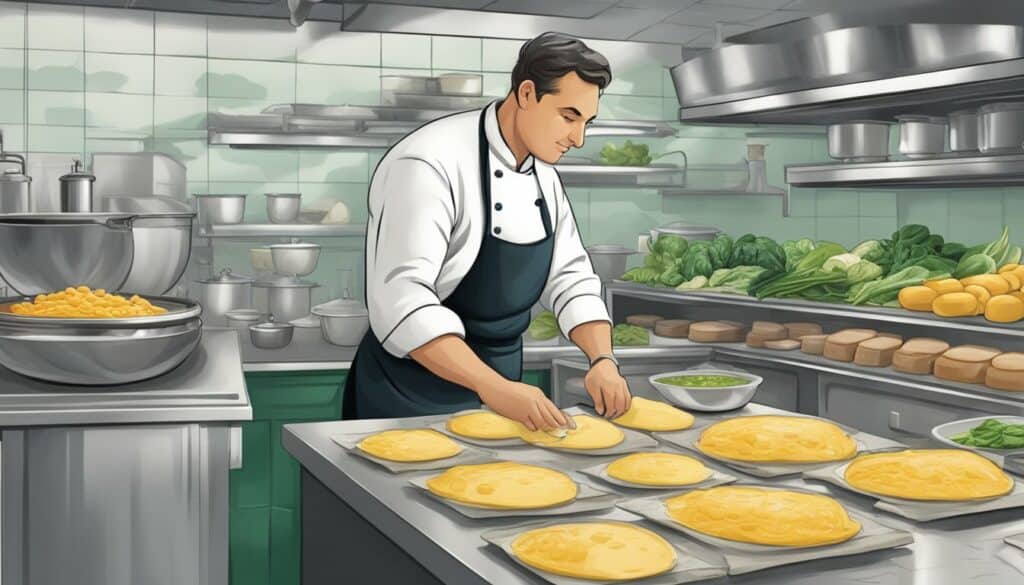How to Cook Ravioli: A Step-by-Step Guide

Table of Contents
Understanding Ravioli
Ravioli is a type of filled pasta that originated in Italy. It is made by folding a thin layer of pasta dough around a filling, typically made of cheese, meat, or vegetables. Ravioli can be served fresh or dried, and can be filled with a variety of ingredients.
Fresh ravioli is usually made with a mixture of flour, eggs, and water. Homemade ravioli can also be made from scratch by rolling out the dough and cutting it into small squares or circles. The filling is then placed in the center of the dough, and the edges are sealed together to create a pocket.
Ravioli can be cooked in a variety of ways, including boiling, baking, or frying. Boiling is the most common method, and fresh ravioli usually only takes a few minutes to cook. Dried ravioli may take longer to cook, depending on the thickness of the pasta.
When making ravioli, it’s important to use high-quality ingredients and to pay attention to the texture of the dough. The dough should be smooth and elastic, and the filling should be well-seasoned and not too wet. Experiment with different fillings and cooking methods to find the perfect combination for your taste.
In summary, ravioli is a delicious and versatile type of pasta that can be made with a variety of fillings and cooked in a variety of ways. Whether you prefer fresh ravioli or homemade ravioli from scratch, it’s easy to make and a great addition to any meal.
Choosing Your Ingredients
When it comes to making ravioli, the ingredients you choose can make a big difference in the final result. Here are some tips on selecting the right ingredients for your dish:
Pasta
The pasta is the foundation of your ravioli dish, so it’s important to choose the right type of pasta. You can use fresh pasta or dried pasta, but fresh pasta is generally considered to be the best option. If you’re making your own pasta, use a mixture of flour and eggs to create a dough that is easy to work with and has a good texture.
Filling
The filling is what gives your ravioli its flavor and texture. You can choose from a variety of fillings, including meat, cheese, butternut squash, mushrooms, and lobster. If you’re making a meat filling, be sure to use high-quality meat that is lean and flavorful. For a vegetarian option, try using ricotta cheese mixed with butternut squash or mushrooms.
Sauce
The sauce is what ties everything together and adds flavor to your dish. You can use a variety of sauces, including tomato sauce, lobster ravioli sauce, sage butter, or simply olive oil. Choose a sauce that complements the flavors of your filling and pasta.
Cheese
Cheese is a common ingredient in many ravioli dishes. Parmesan cheese is a popular choice, but you can also use other types of cheese, such as ricotta or mozzarella. Be sure to choose a cheese that melts well and has a good flavor.
Other Ingredients
Other ingredients that can be added to your ravioli dish include asparagus, meat filling, and pasta sauce. These ingredients can add flavor and texture to your dish, so be sure to choose them carefully.
Overall, choosing the right ingredients is key to making a delicious and flavorful ravioli dish. By using high-quality ingredients and selecting flavors that complement each other, you can create a dish that is sure to impress.
Preparing the Dough
To make ravioli, you’ll need to start by preparing the pasta dough. Here’s how I do it:
- Combine 2 cups of semolina flour and 1 cup of all-purpose wheat flour in a mixing bowl.
- Create a well in the center of the flour mixture and crack 3 large eggs into it.
- Use a fork to whisk the eggs and gradually incorporate the flour, starting from the edges of the well and working your way inward.
- Once the dough starts to form, use your hands to knead it for about 10 minutes until it becomes smooth and elastic.
- Wrap the dough in plastic wrap and let it rest at room temperature for at least 30 minutes before rolling it out.
If you don’t want to make the dough from scratch, you can also use fresh pasta sheets or store-bought ravioli dough. Just make sure to follow the package instructions for cooking and handling.
If you’re making homemade pasta dough, you can also use a pasta machine to roll out the dough into thin, even sheets. This will make it easier to cut and shape the ravioli.
Once you’ve rolled out the dough, use a square cookie cutter or a sharp knife to cut it into even squares. You can also use a ravioli stamp or cutter to create the classic ravioli shape.
If you’re not planning to use all the ravioli immediately, you can store them in the freezer for later. Just make sure to dust them with flour and place them on a baking sheet in a single layer before freezing. Once they’re frozen, you can transfer them to a freezer-safe container or bag.

Shaping the Ravioli
To shape the ravioli, I prefer to use a ravioli stamp or cutter. However, if you don’t have one, you can use a cookie cutter or a sharp knife.
Here are the steps to shape the ravioli:
- Roll out the pasta dough with a rolling pin until it is thin and even.
- Use a ravioli stamp or cutter to cut out circles of dough. Alternatively, you can use a cookie cutter or sharp knife to cut out squares or rectangles.
- Place a spoonful of filling in the center of each circle of dough.
- Brush the edges of the dough with egg wash.
- Place another circle of dough on top of the filling and press the edges together to seal.
- Use a pastry wheel or sharp knife to trim the edges of the ravioli.
- Repeat until all the dough and filling is used up.
If you don’t have a ravioli stamp or cutter, you can use a fork to crimp the edges of the ravioli. Simply press the edges together with a fork to create a decorative edge.
Using a ravioli maker or press can also make the process easier and more efficient. Simply place the dough and filling in the mold, press down, and the ravioli will be shaped and sealed for you.
Overall, shaping ravioli is a fun and creative process that can be done with a variety of tools and techniques.
Cooking the Ravioli
To cook ravioli, I start by boiling water in a pot. I make sure to use enough water to cover the ravioli completely. The general rule of thumb is to use 4-6 quarts of water per pound of ravioli.
Once the water is boiling, I add salt to taste. Then, I gently add the ravioli to the pot. It’s important not to overcrowd the pot, as this can cause the ravioli to stick together.
I cook the ravioli for about 3-4 minutes for fresh ravioli, and 4-6 minutes for frozen ravioli, or until they are al dente. Overcooking the ravioli can cause them to become mushy and lose their shape.
If I want to add some extra flavor to my ravioli, I sometimes cook them in a skillet with some butter or olive oil after boiling them. This gives them a slightly crispy texture and a delicious flavor.
Here are some quick boiling instructions for cooking ravioli:
- Boil 4-6 quarts of water per pound of ravioli in a pot.
- Add salt to taste.
- Gently add the ravioli to the pot, being careful not to overcrowd it.
- Cook for 3-4 minutes for fresh ravioli, and 4-6 minutes for frozen ravioli, or until they are al dente.
- Drain the ravioli and serve as desired.
Overall, cooking ravioli is a simple and delicious process that can be easily customized to suit your tastes.

Storing and Serving
When it comes to storing ravioli, it’s important to keep them fresh so they can be enjoyed later. Here are some tips on how to store and serve ravioli:
- If you’re making a large batch of ravioli, it’s best to freeze them. Place the ravioli on a baking sheet in a single layer and freeze until solid. Then, transfer them to a resealable plastic bag and store in the freezer for up to three months.
- If you’re planning to cook the ravioli within a day or two, you can store them in the refrigerator. Place them in an airtight container or resealable plastic bag and refrigerate for up to two days.
- When it’s time to cook the ravioli, bring a large pot of salted water to a boil. Add the ravioli and cook until they float to the top, about 2-4 minutes depending on whether they are fresh or frozen.
- Drain the ravioli and serve with your favorite sauce. Some popular Italian recipes for ravioli include ravioli piccata and lemon brown butter.
- If you have leftovers, refrigerate them in an airtight container for up to two days. To reheat, simply bring a pot of salted water to a boil and add the ravioli. Cook until heated through, about 2-3 minutes.
In our test kitchen, we’ve found that storing ravioli in the freezer is the best way to ensure they stay fresh for longer periods. However, if you’re planning to cook them within a day or two, storing them in the refrigerator is a good option. Whether you’re making an Italian recipe or just enjoying ravioli as a quick and easy meal, these tips will help you store and serve them with confidence.